Night shuttles are essential for late-night transportation, but they come with significant safety risks that can endanger both passengers and drivers. Factors such as increased crime rates, reduced visibility, and driver fatigue contribute to a heightened potential for accidents and security issues. Additionally, reduced service availability can lead to longer wait times, further complicating the safety and satisfaction of those relying on these services.
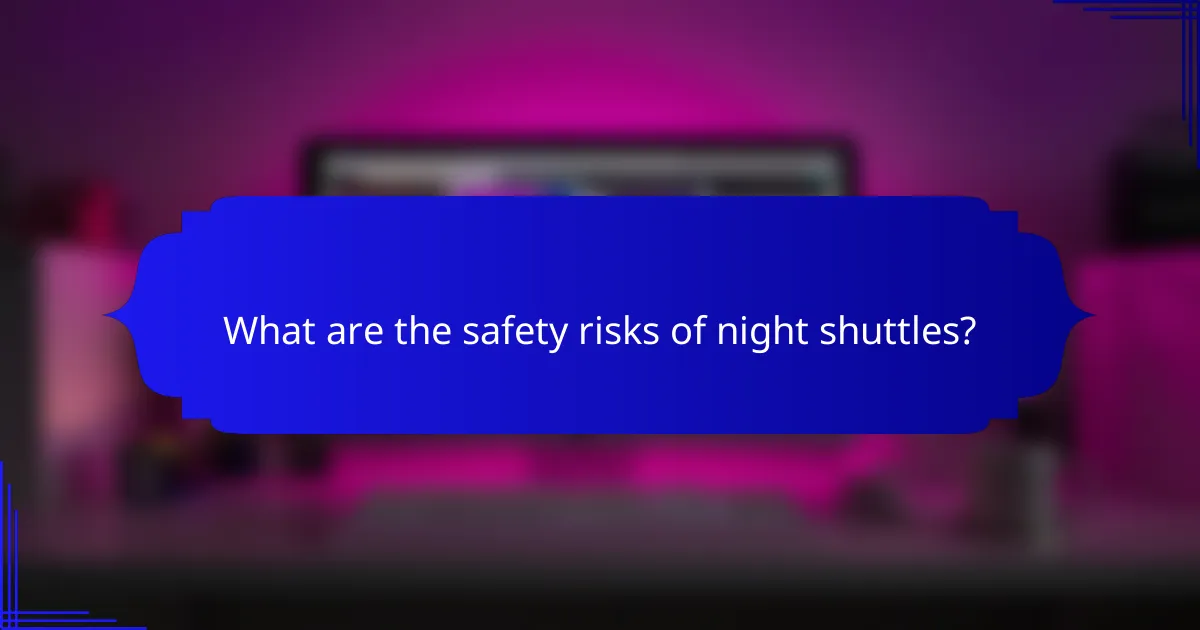
What are the safety risks of night shuttles?
Night shuttles face several safety risks that can compromise passenger security and driver performance. Key concerns include increased crime rates, reduced visibility, and driver inattention, all of which can lead to dangerous situations for both passengers and drivers.
Increased crime rates
Nighttime travel often correlates with higher crime rates, particularly in urban areas. Passengers may be more vulnerable to theft or assault during late hours when fewer people are around and public services are limited.
To mitigate risks, passengers should remain vigilant, avoid displaying valuables, and choose well-lit pick-up and drop-off locations. Utilizing shuttle services with good reputations and safety records can also enhance security.
Reduced visibility
Reduced visibility at night significantly impacts driving conditions, making it harder for drivers to see pedestrians, cyclists, and other vehicles. This can lead to increased chances of accidents and near-misses.
Shuttle operators should ensure their vehicles are equipped with functioning headlights and taillights. Passengers can contribute to safety by wearing reflective clothing and using lights when walking to and from shuttle stops.
Driver inattention
Driver fatigue is a common issue during night shifts, leading to decreased attention and slower reaction times. Long hours without adequate breaks can exacerbate this problem, increasing the likelihood of accidents.
To combat driver inattention, shuttle companies should implement strict scheduling policies that limit driving hours and mandate regular breaks. Passengers can help by reporting any signs of driver fatigue or erratic behavior to the shuttle service.
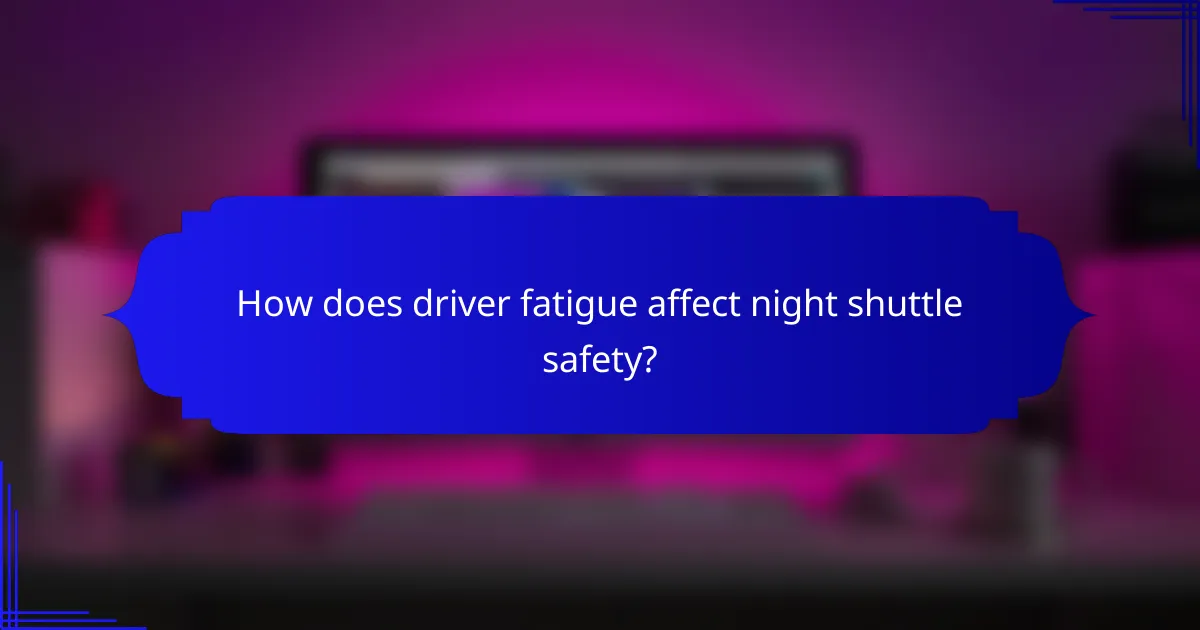
How does driver fatigue affect night shuttle safety?
Driver fatigue significantly compromises night shuttle safety by impairing a driver’s ability to operate a vehicle effectively. Fatigued drivers are more prone to making errors, which can lead to accidents and jeopardize passenger safety.
Increased accident rates
Fatigue is a leading factor in many road accidents, particularly in night shuttles where drivers often work long hours. Studies indicate that drowsy driving can double the risk of a crash, as tired drivers may fail to notice hazards or misjudge distances.
For night shuttle services, the risk of accidents increases during late-night hours when fatigue levels are typically higher. Operators should monitor driving hours and implement strict limits to reduce the likelihood of fatigued driving.
Slower reaction times
Driver fatigue results in slower reaction times, which can be critical in emergency situations. A tired driver may take several seconds longer to respond to sudden obstacles or changes in traffic conditions, increasing the chance of collisions.
Research shows that reaction times can be delayed by tens of percent when a driver is fatigued. Night shuttle services should prioritize training drivers on recognizing fatigue symptoms and encourage regular breaks to maintain alertness on the road.

What are the impacts of reduced service availability?
Reduced service availability in night shuttles can lead to significant inconveniences for passengers, including longer wait times and increased stress. These factors can affect overall safety and satisfaction with the service.
Longer wait times
With fewer shuttles operating during the night, passengers may experience longer wait times for their rides. This can range from a few extra minutes to potentially over half an hour, depending on demand and the frequency of available services.
Longer wait times can lead to passengers feeling anxious or unsafe, especially in poorly lit or isolated areas. It is advisable for passengers to plan their travel times accordingly and consider alternative transportation options if wait times are expected to be significant.
Higher passenger stress levels
Reduced service availability often results in higher stress levels among passengers. The uncertainty of when a shuttle will arrive can create anxiety, particularly for those who may be traveling alone or late at night.
To mitigate stress, passengers should stay informed about shuttle schedules and consider using ride-sharing apps as a backup. Additionally, traveling in groups can enhance safety and reduce individual stress during longer waits.
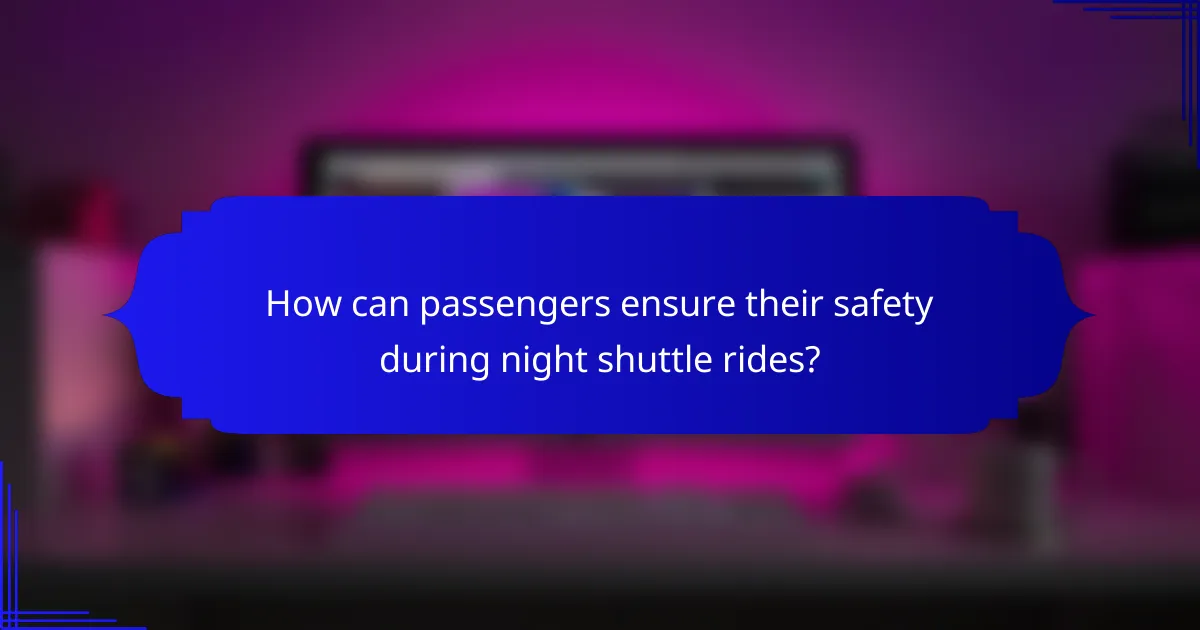
How can passengers ensure their safety during night shuttle rides?
Passengers can enhance their safety during night shuttle rides by choosing reliable services, traveling in groups, and staying vigilant about their surroundings. These proactive measures can significantly reduce risks associated with nighttime travel.
Choose reputable shuttle services
Selecting a reputable shuttle service is crucial for ensuring safety during night rides. Look for companies with positive reviews, established safety records, and proper licensing. Checking for certifications and compliance with local regulations can also provide peace of mind.
Consider services that use well-maintained vehicles and employ trained drivers. Some shuttle companies may even offer tracking features, allowing passengers to share their ride details with friends or family for added security.
Travel in groups
Traveling in groups can greatly enhance safety during night shuttle rides. There is safety in numbers, as groups are less likely to be targeted for crime. If possible, coordinate with friends or fellow travelers to share a shuttle, making the experience safer and more enjoyable.
When traveling alone, consider waiting for the shuttle in well-lit, populated areas. If you must travel solo, inform someone of your plans and estimated arrival time to ensure someone is aware of your journey.
Stay aware of surroundings
Maintaining awareness of your surroundings is essential for safety during night shuttle rides. Stay alert to your environment, including the behavior of other passengers and the driver. If something feels off, trust your instincts and consider exiting the shuttle at a safe location.
Keep personal belongings secure and avoid distractions like excessive phone use. Being attentive can help you identify potential risks and react appropriately, ensuring a safer travel experience.
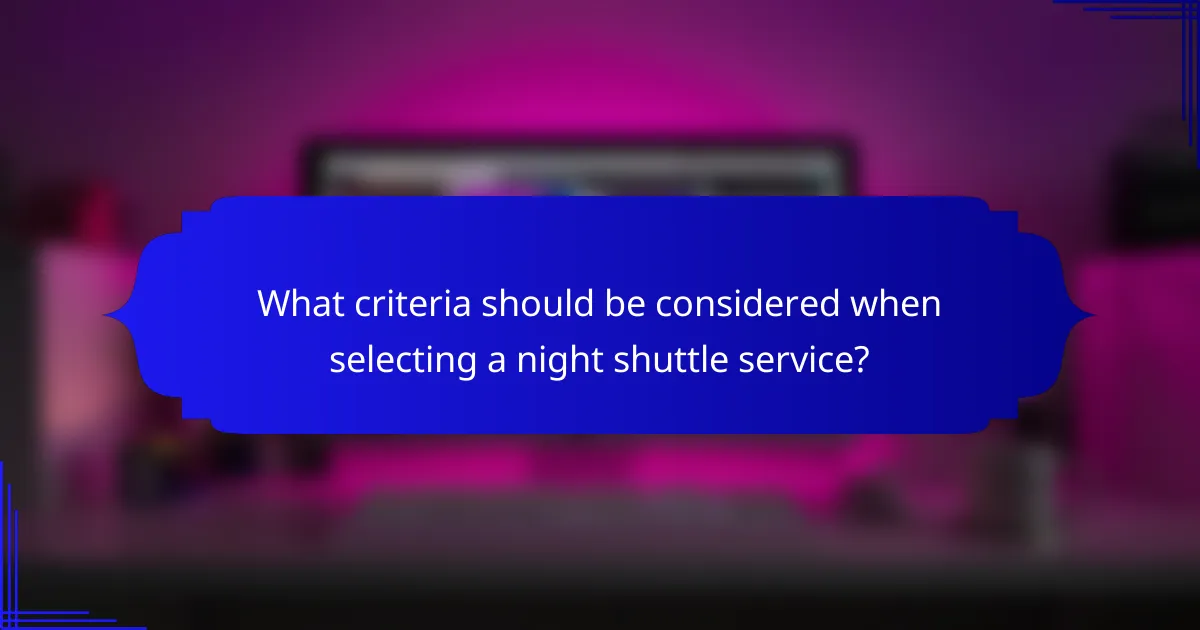
What criteria should be considered when selecting a night shuttle service?
When selecting a night shuttle service, prioritize driver experience and service reviews. These factors significantly impact safety, reliability, and overall customer satisfaction.
Driver experience
Driver experience is crucial for ensuring safe and efficient night shuttle operations. Look for services that employ drivers with several years of experience, particularly in nighttime driving conditions, which can be more challenging due to reduced visibility and fatigue.
Consider asking about the training drivers receive, including defensive driving techniques and emergency response protocols. A well-trained driver can navigate unexpected situations more effectively, enhancing passenger safety.
Service reviews
Service reviews provide valuable insights into the reliability and quality of a night shuttle service. Check online platforms for customer feedback, focusing on comments about punctuality, vehicle condition, and driver professionalism.
Look for services with consistently high ratings and positive testimonials. A service with a strong reputation is more likely to prioritize safety and customer satisfaction, making it a better choice for your nighttime travel needs.

What are the legal regulations for night shuttle services in the UK?
Night shuttle services in the UK must comply with specific legal regulations that ensure passenger safety and service reliability. These regulations cover licensing, insurance, and operational standards to mitigate risks associated with nighttime travel.
Licensing requirements
To operate a night shuttle service in the UK, companies must obtain a valid operator’s license from the local transport authority. This license ensures that the service meets safety and operational standards, including vehicle maintenance and driver qualifications.
Drivers must hold a valid taxi or private hire license, which typically requires background checks and completion of a driving assessment. Compliance with these licensing requirements is crucial to avoid legal penalties and ensure passenger safety.
Insurance obligations
Night shuttle services are required to have comprehensive insurance coverage that includes public liability and vehicle insurance. This insurance protects both the company and passengers in case of accidents or injuries during transit.
Operators should regularly review their insurance policies to ensure they meet the minimum legal requirements and adequately cover potential risks associated with nighttime operations. Failure to maintain proper insurance can result in significant financial liabilities and legal repercussions.
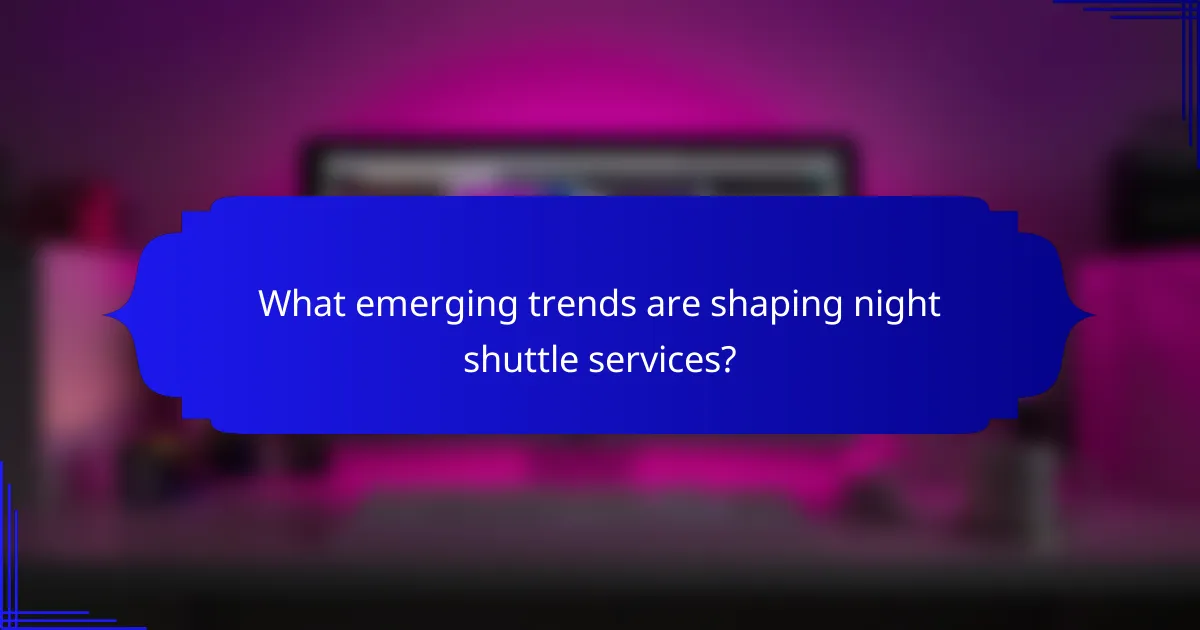
What emerging trends are shaping night shuttle services?
Emerging trends in night shuttle services focus on enhancing efficiency and safety for passengers. Increased use of technology and a heightened emphasis on passenger safety are key factors driving these changes.
Increased use of technology
Technology is transforming night shuttle services by improving communication and operational efficiency. Real-time tracking apps allow passengers to monitor shuttle locations, reducing wait times and enhancing convenience.
Additionally, automated systems for scheduling and dispatching can optimize routes and minimize delays. This tech-driven approach not only streamlines operations but also helps in managing driver fatigue by ensuring more balanced workloads.
Focus on passenger safety
Passenger safety has become a top priority for night shuttle services, leading to the implementation of various safety measures. Enhanced driver training programs and background checks are now standard to ensure that drivers are well-prepared for the challenges of night driving.
Moreover, many services are adopting safety features like in-vehicle cameras and emergency alert systems. These technologies provide an added layer of security, reassuring passengers during their journeys at night.
